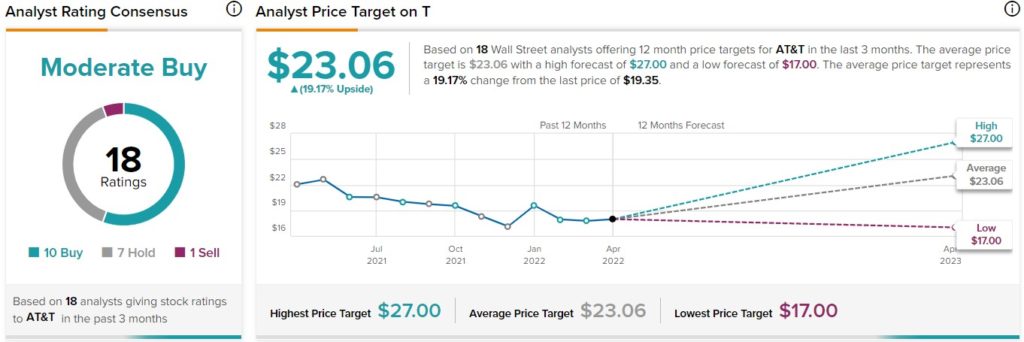Headquartered in Dallas, AT&T (T) is a giant in the telecommunications, media, and technology services industries. I am bullish on the stock.
You’d be hard-pressed to find an older and bigger U.S. telecommunications and media business than AT&T. However, like all other businesses, the iconic company has had its fair share of ups and downs.
In particular, AT&T has faced stiff competition in the area of streaming entertainment content, as well as wireless and fiber networks. The skeptics might express concern that the company is falling behind and won’t be able to generate robust revenue anymore.
T stock hasn’t been a great performer over the past year. Yet, this doesn’t mean that AT&T isn’t hitting its financial targets and providing value to the shareholders.
Ultimately, succeeding as an AT&T investor means being patient and playing the long game. A closer inspection of the fiscal stats will reveal that this old telecom mainstay can still generate strong revenue in some of the most important market segments.
Almost Recession-Proof
Momentum-focused traders probably won’t like this, but T stock has exhibited a gradual downtrend over the past 12 months. AT&T stock once seemed poised to break above $25 but now struggled just to hold $20.
On the other hand, reduced prices aren’t necessarily a bad thing, as they can lead to prime buying opportunities. After the share-price decline, AT&T’s trailing 12-month price-to-earnings (P/E) ratio is 7. This indicates a bargain that ought to be hard for value investors to resist.
What about income investors, though? The company offers a forward annual dividend yield of 5.7%, which is nothing to sneeze at.
The next dividend payment date for AT&T’s common shareholders is scheduled for May 2. If you don’t qualify for that dividend distribution, though, don’t worry. AT&T is well-capitalized and should continue to reward investors who stay in the trade for the long term.
As an additional point, we should note that T stock’s five-year monthly beta of 0.65 is very low. This suggests that the stock is less volatile than the market because it has historically moved slower, in both directions, than the overall stock market. Consequently, you can hold AT&T stock and sleep soundly at night, even during times of market turbulence.
I wouldn’t go so far as to claim that T stock is recession-proof, and neither would AT&T CEO John Stankey, though he does make a compelling argument that his company offers products and services that should remain in high demand even during economic turbulence.
“I don’t want to say we’re recession-proof. I don’t think any business is recession-proof. But when we do our customer research and ask them if they’d prefer to give up their cellphone, their electricity, their vehicle, other things first—we rank very high on that. We’re one of the few services our customers will fight to keep,” Stankey contended.
The Right Kind of Revenue
An argument can be made that an investment in AT&T is recession-resistant, but the company still has to continually demonstrate its ability to generate revenue. As it turns out, AT&T’s first-quarter 2022 results provide a mixed fiscal picture, but there are highlights that confirm the company’s strength in essential market segments.
First, there’s the bad news. For Q1 2022, AT&T reported a 13.3% decline in consolidated revenue to $38.1 billion. To account for these disappointing results, the company cited “the impact of divested businesses, mainly U.S. Video in the third quarter of 2021 and Vrio in the fourth quarter of 2021, as well as lower Business Wireline revenues.”
Now, here’s the good news. In 2022’s first quarter, AT&T made strides in its Wireless and Fiber/Broadband segments. Stankey was apparently eager to point this out, saying, “We had our best first quarter for postpaid phone net adds in more than a decade, and our fiber broadband net adds remain consistently strong.”
The numbers do appear to support the thesis that AT&T remains a strong contender in providing connectivity. Thus, the company’s Consumer Broadband revenue increased 6.8% year-over-year due to Fiber growth of 24.7%; Mobility revenue rose 5.5% year-over-year; and AT&T recorded 289,000 fiber net additions, with penetration of 37%, for an increase of around 200 basis points.
All in all, AT&T is holding its own as a provider of fiber and broadband connectivity services. Going forward, the company will need to maintain its progress in these areas while also showing growth in its media/entertainment segments.
Wall Street’s Take
Turning to Wall Street, T stock is a Moderate Buy based on 10 Buys, seven Holds, and one Sell rating. The average AT&T price target is $23.06, implying 19.2% upside potential.

The Takeaway
The analysts on Wall Street seem to envision higher prices for T stock, so perhaps they’re not too worried about the decline in AT&T’s consolidated revenue. What’s important is that, as a connectivity provider, AT&T can prove that the company is making progress.
Besides, T stock offers a solid dividend yield, low volatility, and deep value for contrarian investors. Sure, there’s a lot of competition out there, and AT&T will have to step up its game in certain respects. However, there’s no need to dismiss this sometimes ignored yet still iconic telecom giant.
Discover new investment ideas with data you can trust.
Read full Disclaimer & Disclosure









